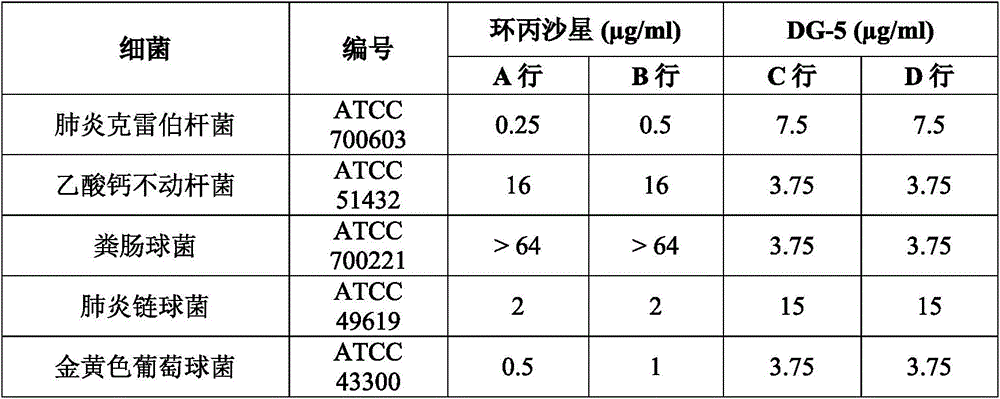Application of medicinal nano-material composition DG-5 to resistance of drug resistant bacteria
A technology of nanomaterials and compositions, applied in the field of medicine, can solve the problems such as limiting the application of nanosilver materials, anti-super-resistant bacteria of nanosilver, and the influence of reducing agents, etc. have not yet been seen
- Summary
- Abstract
- Description
- Claims
- Application Information
AI Technical Summary
Problems solved by technology
Method used
Image
Examples
Embodiment 1
[0023]Embodiment 1: pharmaceutical nanomaterial composition DG-5, is made up of the composition of following concentration: spherical nano-silver powder 1-2g / L, glucose 1-2g / L, all the other are water; Described spherical nano-silver powder particle size 0.1-5nm (purchased from Hunan Optics Valley Nano Technology Co., Ltd.), the purity of silver in the spherical nano-silver powder is ≥99.99%.
Embodiment 2
[0024] Example 2: Determination of the activity of the pharmaceutical nanomaterial composition DG-5 against 5 strains of drug-resistant bacteria (Klebsiella pneumoniae, Acinetobacter calcoaceticus, Enterococcus faecalis, Streptococcus pneumoniae, Staphylococcus aureus).
[0025] In this study, the minimum inhibitory concentration was used as the index of antibacterial activity. The minimum inhibitory concentration refers to the lowest compound concentration (Minimum inhibitory concentration, MIC) that can inhibit the growth of a certain microorganism. The minimum inhibitory concentration was determined with reference to the micro-medium dilution method of the Clinical and Laboratory Standards Institute Guidelines (CLSI). In this study, the minimum inhibitory concentrations of a test sample DG-5 and a control antibiotic ciprofloxacin against 5 strains of bacteria were tested. The test sample DG-5 was diluted two-fold from the highest detection concentration of 30 μg / ml in a 96...
Embodiment 3
[0048] Example 3: Determination of the activity of the pharmaceutical nanomaterial composition DG-5 against 5 strains of super drug-resistant bacteria.
[0049] Using the same method as in Example 2, the pharmaceutical nanomaterial composition DG-5 is resistant to 5 strains of super drug-resistant bacteria (Enterobacter cloacae, Klebsiella pneumoniae, Escherichia coli, Pseudomonas aeruginosa, Baumannii Bacteria) activity was measured. The minimum inhibitory concentration of the reference substance ciprofloxacin tested together is consistent with the historical data, and it is finally determined that the minimum inhibitory concentration of the test sample DG-5 against 5 strains of bacteria is between 1.875-3.75μg / ml, which is far better than the positive Antibacterial activity of the control drug ciprofloxacin.
[0050] 1. Materials
[0051] bacterial strain
[0052] bacterial species
Enterobacter cloacae
G-
...
PUM
| Property | Measurement | Unit |
|---|---|---|
| particle diameter | aaaaa | aaaaa |
| particle diameter | aaaaa | aaaaa |
| particle diameter | aaaaa | aaaaa |
Abstract
Description
Claims
Application Information
 Login to View More
Login to View More - R&D
- Intellectual Property
- Life Sciences
- Materials
- Tech Scout
- Unparalleled Data Quality
- Higher Quality Content
- 60% Fewer Hallucinations
Browse by: Latest US Patents, China's latest patents, Technical Efficacy Thesaurus, Application Domain, Technology Topic, Popular Technical Reports.
© 2025 PatSnap. All rights reserved.Legal|Privacy policy|Modern Slavery Act Transparency Statement|Sitemap|About US| Contact US: help@patsnap.com



